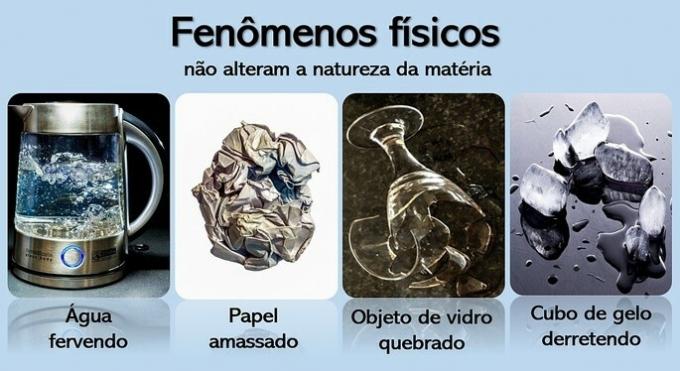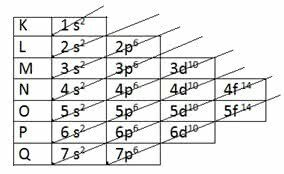In a physical phenomenon, the substance maintains its identity, as the change only occurs in its shape. The chemical phenomenon is characterized by the formation of a new substance, that is, the nature of matter is modified.
For example, the melting of ice is a physical phenomenon, because although matter has changed state, it is still water.
Wood burning is a chemical phenomenon, which occurs through a combustion reaction while wood (fuel) ignites.
Therefore, we can distinguish a chemical phenomenon from a physical phenomenon basically by the composition. If after the change the material remains with the same composition, then the phenomenon is physical. If a new substance is formed, we have a chemical phenomenon.
See below for more examples of physical and chemical phenomena in our daily lives.
physical phenomena
Physical phenomena are related to the aspect of the material. Although they do not change the identity, boiling, melting, freezing and grinding, for example, can cause a transformation in the material.
Examples of physical phenomena
- Melting an ice cube
- boiling water
- Mothball sublimation
- Acetone evaporation
- casting a metal
- Dissolving sugar in water
- break a stone
- crumple a paper
- break a glass cup
- knead a can

Also read about physical states of matter and physical state changes.
chemical phenomena
A chemical phenomenon promotes a chemical change in a material because of chemical reactions. This happens because the substances that initially constituted it are separated and a rearrangement of the atoms causes new substances to be produced.
For example, cooking gas burns from a combustion reaction and a nail rusts from the oxidation reaction of iron.
Examples of chemical phenomena
- fruit rot
- emergence of rust on a nail
- cooking a food
- Burning a fuel (gasoline, wood, cooking gas)
- sugar caramelization
- growing a cake
- food digestion
- Fireworks
- Effervescence of a pill
- Transformation of wine into vinegar
- Decomposition of food in garbage

know more about chemical transformations and chemical reactions.
Difference between physical phenomenon and chemical phenomenon
Basically, we can differentiate the two types of transformations when observing the formation of a new substance. If a new material has formed, this indicates that a chemical phenomenon has occurred. Chemical reactions are usually identified when it occurs
- temperature change
- Gas release
- odor release
- color change
- sound production
- light emission
- Formation of a solid at the bottom of a container with liquid
Furthermore, a chemical phenomenon can only be undone through a new chemical reaction.
When there is a change in appearance, such as size, shape and color, but the identity of the matter remains the same, we observe a physical phenomenon. Therefore, in a physical phenomenon, substances can be mixed, but they do not react with each other.
Also read about physical and chemical transformations.
Exercises on physical and chemical phenomena
question 1
Judge the following items and check C for correct and E for wrong.
I. When the milk turns sour, it means that a physical phenomenon has occurred.
II. When pouring bleach on a colored cotton garment, the fabric becomes discolored by a chemical phenomenon.
III. The production of fertilizer using food waste occurs through a physical phenomenon.
IV. When lighting a match, the friction between the toothpick and the box triggers a chemical phenomenon.
The sentences are correct:
a) I and III
b) II and IV
c) III and IV
d) All alternatives
Correct alternative: b) II and IV.
I. WRONG. Bacteria present in milk over time transform lactose, milk sugar, into lactic acid. So it's a chemical phenomenon.
II. CORRECT Bleach is a bleach with substances formed by chlorine, which are oxidizing agents capable of “whitening” the fabric.
III. WRONG. The transformation of food waste into fertilizer occurs through the action of microorganisms that degrade organic matter, therefore it is a chemical phenomenon.
IV. CORRECT When lighting a match, a combustion reaction occurs.
question 2
Classify the following situations as physical phenomenon (F) or chemical phenomenon (Q):
1. Reddish coloration on wet steel wool
2. Melting ice by supplying heat
3. Dissolving an effervescent tablet in water
4. Settling of solids in a water treatment tank
5. Disappearance of mothballs
The correct sequence is:
a) Q, Q, F, F, F
b) F, F, Q, Q, F
c) Q, F, Q, F, F
d) F, Q,Q, F,Q
Correct alternative: c) Q, F, Q, F, F.
1. The contact of the steel sponge with water and oxygen causes the material to oxidize, that is, it is a chemical phenomenon.
2. Water changes to a solid state when it reaches a temperature of 0°C. When providing heat, for example, taking the ice cube out of the freezer and placing it at temperature environment causes water to return to a liquid state, a change of state that characterizes a phenomenon physicist.
3. Effervescence corresponds to the release of gas into a liquid, which is perceptible by the formed bubbles, characterizing a chemical phenomenon. Contact of stomach antacids with water, for example, causes a reaction to occur and carbon dioxide to be released.
4. Due to the action of gravity, the impurities present in the water are deposited at the bottom of the tank, that is, it is a physical phenomenon.
5. Mothballs is a substance that under ambient conditions undergoes sublimation, which is the change from solid to gaseous state. Therefore, it is a physical phenomenon.
question 3
Consider the following blends:
1. Baking soda and vinegar
2. water and sugar
3. stomach antacid and water
4. Oxygen gas and carbon dioxide
When mixing the substances, a chemical transformation occurs in:
a) 1 and 4
b) 2 and 3
c) 1 and 3
d) 2 and 4
Correct alternative: c) 1 and 3.
1. Chemical transformation. When mixing baking soda and vinegar, a chemical reaction occurs, evidenced by the effervescence caused by producing carbon dioxide.
2. Physical transformation. Dissolving sugar in water forms a homogeneous mixture, but does not produce a chemical change.
3. Chemical transformation. A chemical reaction takes place and there is the release of carbon dioxide, which is identified by the formed bubbles.
4. It is a homogeneous mixture of two gases without any transformation.
question 4
(PUC-SP) Consider the following homemade recipe for preparing a cornmeal cake:
I. Thoroughly mix 3 eggs, 2 cups sugar, 1 ½ cup cornmeal, 1 cup milk, 6 tablespoons oil, 1 tablespoon baking powder and beat until smooth.
II. Add fennel to taste and pour into the previously greased baking dish.
III. Place in a preheated oven until the cake is baked and browned.
There is a chemical transformation in:
a) I, only.
b) II, only.
c) III, only.
d) I and III only.
e) I, II and III.
Correct alternative: c) III, only.
In I and II only mixtures of the ingredients are made. In III, heating causes the yeast to act more quickly and release carbon dioxide into the dough in the form of bubbles, which are responsible for the cake's growth as it bakes.
Keep testing your knowledge with the exercises:
- Exercises on homogeneous and heterogeneous mixtures
- Exercises on separation of mixtures
- Exercises on properties of matter



